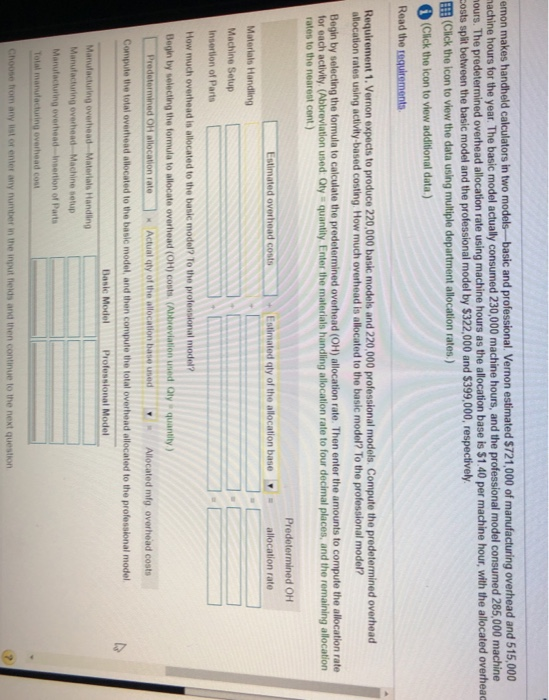emon makes handheld calculators in two models basic and professional. Vernon estimated $721,000 of manufacturing overhead and 515,000 machine hours for the year. The basic model actually consumed 230,000 machine hours, and the professional model consumed 285,000 machine mours. The predetermined overhead allocation rate using machine hours as the allocation base is $1.40 per machine hour, with the allocated overhead costs split between the basic model and the professional model by $322,000 and $399,000, respectively (Click the icon to view the data using multiple department allocation rates) (Click the icon to view additional data) Read the requirements Requirement 1. Vernon expects to produce 220,000 basic models and 220,000 professional models. Compute the predetermined overhead allocation rates using activity-based costing. How much overhead is allocated to the basic model? To the professional model? Begin by selecting the formula to calculate the predetermined overhead (OH) allocation rate. Then enter the amounts to compute the allocation rate for each activity. (Abbreviation used Qty - quantity Enter the material handling allocation rate to four decimal places, and the remaining allocation rates to the nearest cont.) Predetermined OH Estimated overhead coats Estimated qty of the allocation base allocation rate Material Handling Machine Setup Insertion of Parts How much overhead is allocated to the basic model to the professional model? Begin by selecting the formula to allocate overhead (OH) cool (Abbreviation und Qly quantity) Predetermined OH allocation rate Actually of the allocation base und Allocated mig overhead costs Compute the total overhead allocated to the basic model, and then compute the total overhead allocated to the professional model Basle Model Professional Model Manufacturing overhead Material Handling Manufacturing overhead Machine setup Manufacturing overhead Insertion of Parts Total manufacturing overhead con Choose from any list of enter any number in the input neds and then continue to the next question $ Manufacturing overhead-Assembly Manufacturing overhead-Packaging Total manufacturing overhead cost Basic Model Professional Model 427,700 $ 222,300 7,500 63,500 435,200 $ 285,800 $ ead 9th Print Done Vernon wants to further refine its costing system by allocating overhead using activity-based costing. The estimated $721,000 of manufacturing overhead has been divided into three primary activities. Materials Handling, Machine Setup, and Insertion of Parts. The following data have been compiled: Har Insertion of Parts Total Sety Materials Handling $99,000 Number of parts Machine Setup $127.000 Number of setups $ 721,000 $495.000 Number of parts of Overhead costs Allocation Base Expected usage Basic Model Professional Model choy sele 35 parts per calculator 20 setups per year 55 parts per calculator 36 setups per year 35 parts per calculator 55 1. Vernon expects to produce 220,000 basic models and 220,000 professional models. Compute the predetermined overhead allocation rates using activity-based costing. How much overhead is allocated to the basic model? To the professional model? 2. Compare the activity-based costing results from Requirement 1 with the company's results using a single plantwide rate and using multiple department rates. What conclusions can you draw? Requirement 2. Compare the activity-based costing results from Requirement 1 with the company's results using a single plantwide rate and multiple department rates. What conclusions can you draw? Begin by completing the table below to show the total and per unit overhead allocated to each model under each of the three different allocation methods. (Round per unit amounts to the nearest cent.) Basic Model Total MOH Professional Model Total MOH Per Unit Per Unit Single plantwide allocation rate Multiple department allocation rates Activity-based allocation rates What conclusions can you draw? The allocation using is the most accurate because it considers the resources used by each model Management can now see that compared to the costs allocated using the single plantwide rate, the model cost less than expected and the model cost more than expected to produce











